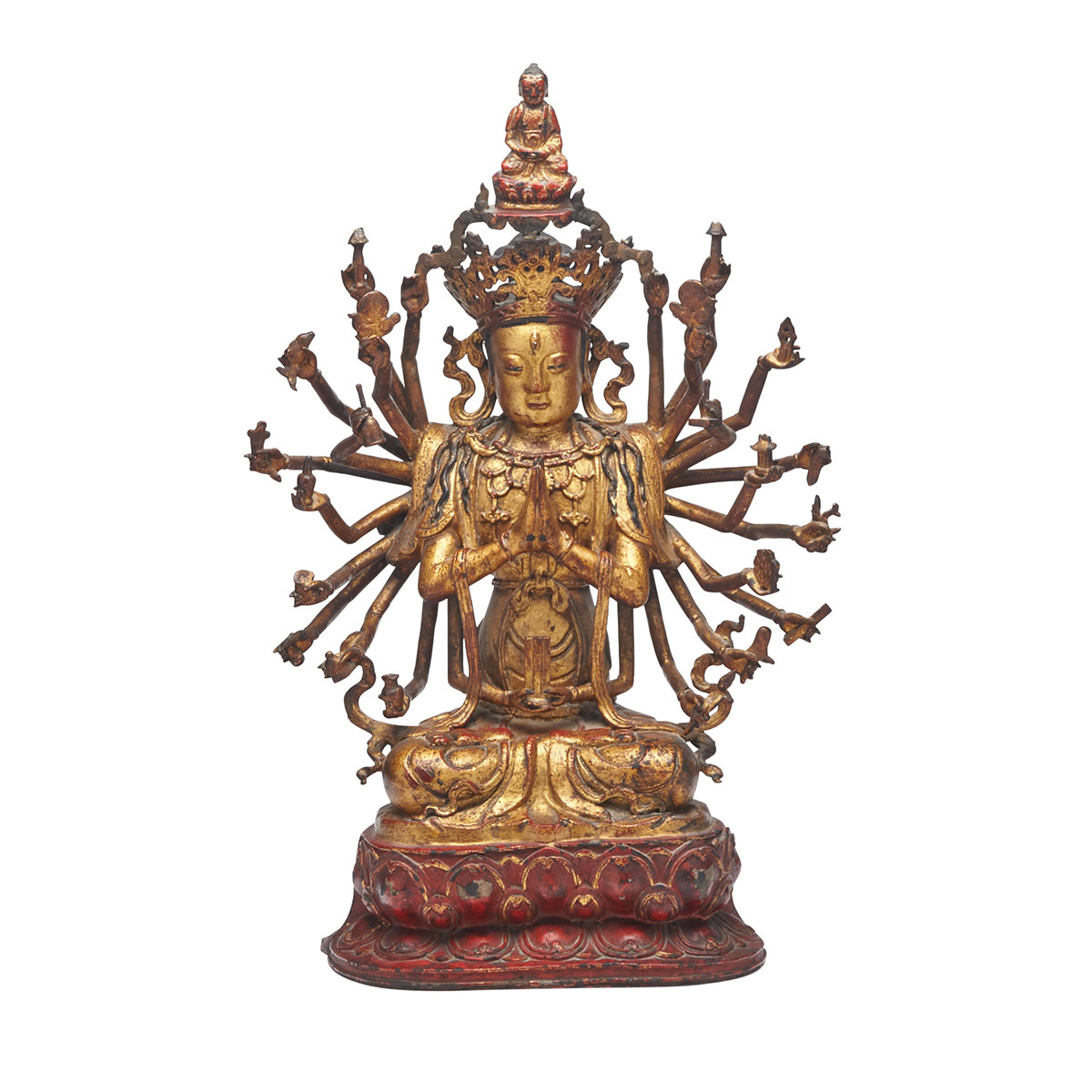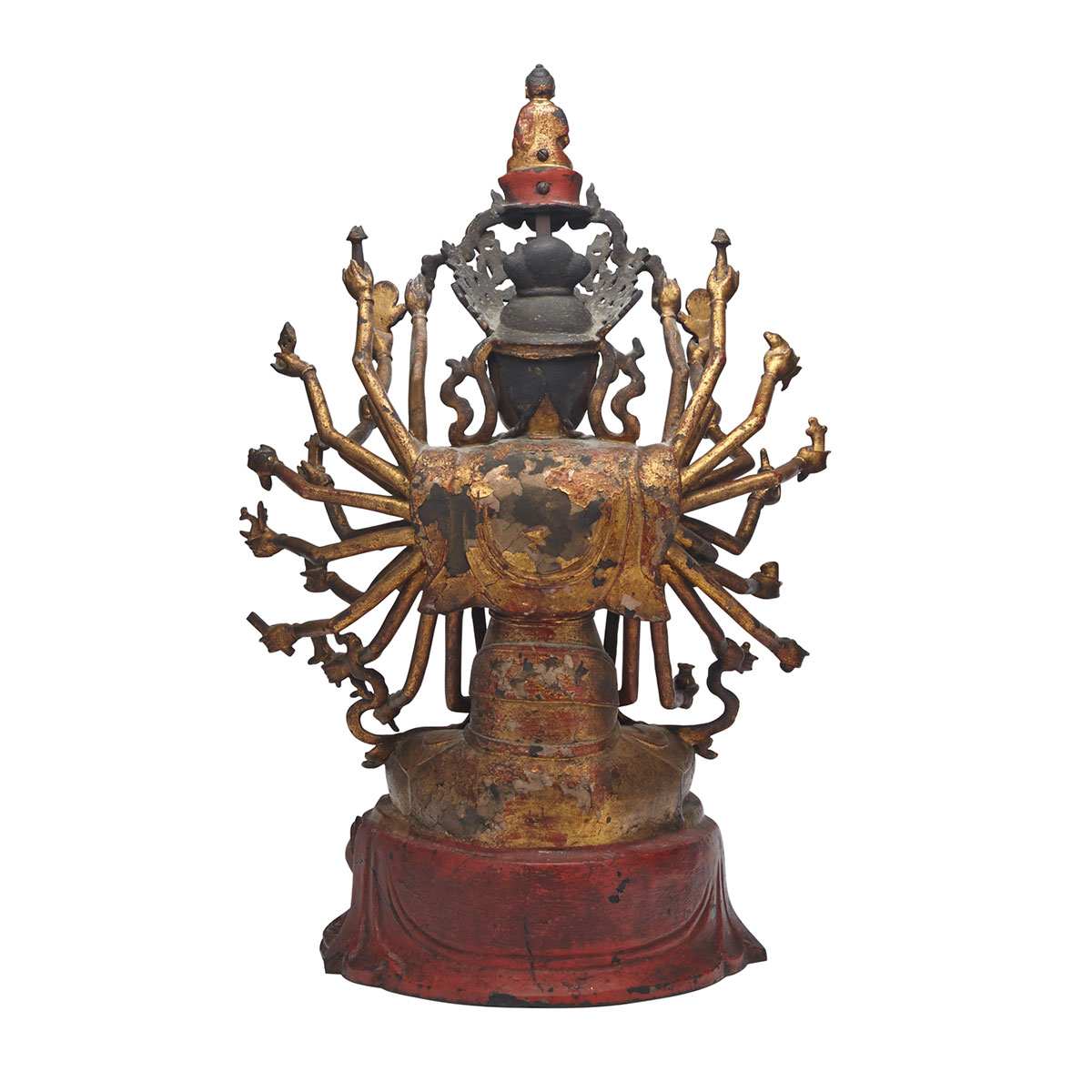Lot 80
Large Gilt and Lacquered Bronze Figure of Thousand-Armed Avalokitesvara, China, 16th Century

Lot 80 Details
Large Gilt and Lacquered Bronze Figure of Thousand-Armed Avalokitesvara, China, 16th Century
Seated in vajrasana on a double lotus pedestal, with the main pairs of hands held in anjalimudra, high chignon, benevolent expression, the elongated uppermost hands held upwards supporting a Buddha, below a seven-leaf diadem modelled with twelve pairs of arms, each hand holding a ritual object including a reliquary, a ritual brush, a mala pearl, ceremonial dagger, ambrosia vase, Wheel of Law, bell, lotus, and other ritual objects, all raised to the sides and a further pair of arms held in front holding a chaojian
height 33.3" — 84.5 cm.
Estimate $20,000-$30,000
Additional Images

Provenance:
The Harry Handel Collection of Chinese and Himalayan Buddhist Sculpture (Lots 77-87)
Purchased during the 1950’s at the Gurie Gallery, Montreal, thence by descent within the family.
Harry Handel (1916-1972) was born in Montreal. Self-educated, he and his friend Louis Melzack both opened bookstores in downtown Montreal during the 1930’s. Handel’s bookshop was Everyman’s Bookshop, and Melzack opened Classics Bookshop. After marrying Louis’ sister, Esther Melzack, Harry and Esther grew their bookstore into an intellectual centre, specializing in exploration, anthropology, religion and art.
Harry Handel became an authority in Canadian art and culture, and has been referenced in numerous publications and books (ref: G. Stevens, In a Canadian Attic; J. Houston, Confessions of an Igloo Dweller). Close friends and customers include leading Canadian artists of the day Arthur Lismer, Sam Borenstein and A.Y. Jackson. Alex Gurie, of Montreal’s famed Gurie Gallery, was also a close friend of Handel’s and taught him to appreciate and collect Asian antiques.
Toward the end of Handel’s life, his second-hand bookshop had grown into an estate buying and art-dealing business. Everyman’s Bookshop closed in 1970 when Handel died at the age of 55. His wife Esther donated a collection of Canadian art to the Leonard and Bina Ellen Galerie of Montreal’s Concordia University in memory of Harry Handel. (ref: Horatio Walker by David Karel).
Waddington’s is proud to offer the Collection of Harry Handel in this auction. Throughout this catalogue, you will find other items from this collection including ivory carvings, Chinese glass, and Chinese jade carvings.
The Estate of Harry Handel (1916-1972), owner of Everyman’s Bookshop in Montreal. Purchased during the 1950’s at the Gurie Gallery, thence by descent within the family.
Note:
Adorned in typical Han-Chinese robes and wearing an elaborate crown, the current example of the 'thousand-armed' Avalokiteshvara is a rare Daoist depiction of a Buddhist bodhisattva. Surmounted by a small figure of Amitabha Buddha (which is missing on many known examples), the well-cast figure represents the Daoist manifestation of the Buddhist deity of wisdom and mercy. His iconography is also characterized by the 24 long, spindly arms radiating from the slender body. One of the most revered deities, the 'thousand-armed' Avalokiteshvara was the earthly depiction of Amitabha Buddha and venerated as the ideal of karuna, the concept of compassion.
During the 15th Century of the Ming Dynasty, Daoism and Buddhism encountered a cross-pollenization of ideas. At that time, the Tibetan Gelug School of Buddhism was founded. In consequence, Han-Chinese Buddhism gradually became the mainstream religion in the Imperial court, surpassing Mongolian Buddhism. In the Yongle and Xuande periods, Tibetan Buddhism became the most prominent religion in China, a fact that was reflected in the Imperial bodhisattvas workshops, known as the ‘Fozuo,’ (the literal Chinese to English translation is ‘workshop of making bodhisattvas’). Owing to the emperor’s religious preferences, Buddhism influenced the majority of bronze figures made in the ‘Fozuo’.
16th Century Daoist-Buddhist bronzes such as this present example are extremely rare. The proportions of his body depict a transition of style between Daoist and Buddhist vocabulary, which is showcased by the 28 arms, seven-leaf diadem, and slender waist. These transitional characteristics bear pivotal historical meanings and support his influence from the early Ming Period. For a comparable example of this figure dated to the Ming Dynasty (but probably 16th Century), see Christie’s Hong Kong, May 27, 2009, lot 1951.




